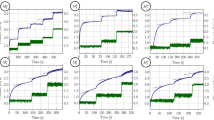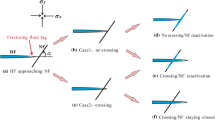Abstract
This paper examines fracture closure in a Mohr-Coulomb pressure-sensitive dilatant material. The analysis is based on fracture propagation and closure of a plane strain geometry using a fully coupled elastoplastic hydraulic fracturing model. It is shown that the closure pattern of a fracture which has first been propagated is completely different from the closure pattern of a pressurized stationary fracture. A pressurized stationary elastoplastic fracture closes uniformly but remains open after the applied load is released. An elastoplastic fracture which has first been propagated, makes surface contact initially near the fracture tip and subsequently towards the mouth of the fracture. Applications of fracture closure pattern can be found in different aspects of hydraulic fracturing such as in the insitu parameters determination from the inversion of the pressure vs time record and in the closure stress on propped fractures.
Similar content being viewed by others
References
Barenblatt, G.I. (1962). Mathematical theory of equilibrium cracks in brittle fracture. Advances in Applied Mechanics 7, 55–129.
Bazant, Z.P. (1986). Mechanics of Distributed Cracking. Applied Mechanics Review 39 (5), 675–705.
Bigoni, D. and Radi, E. (1993). Mode I crack propagation in elastic-plastic pressure-sensitive materials. International Journal of Solids and Structures 30, 899–919.
Dam, D.B. van, de Pater, C.J. and Romijn, R. (1998). Analysis of hydraulic fracture closure in laboratory experiments. Proceedings of the SPE/ISRM Rock Mechanics in Petroleum Engineering,Trondheim, Norway, SPE 47380, Vol. 2, 365–374.
Desroches, J. and Thiercelin, M. (1993). Modelling the propagation and closure of micro-hydraulic fractures. International Journal of Rock Mechanics and Mining Science & Geomechanics Abstracts 30, 1231–1234.
Desroches, J., Detournay, E., Lenoach, B., Papanastasiou, P., Pearson, J.R.A., Thiercelin, M. and Cheng, A. (1994). The crack tip region in hydraulic fracturing. Proceedings of Royal Society. London A447, 39–48.
Detournay, E. (1998). Fluid and solid singularities at the tip of a fluid-driven fracture. Proceedings of IUTAM Symposium on Non-linear Singularities in Deformation and Flow (Edited by D. Durban and J.R.A. Pearson), Kluwer Academic Publishers, Dordrecht, 27–42.
Hillerborg, A., Modeer, M. and Petersson, P.E. (1976). Analysis of crack formation and crack growth in concrete by means of fracture mechanics and finite elements. Cement and Concrete Research 6, 773–782.
Labuz, J.F., Shah, S.P. and Dowding, C.H. (1985). Experimental analysis of crack propagation in granite. International Journal of Rock Mechanics and Mining Science & Geomechanics Abstracts 22 (2), 85–98.
Li, F.Z. and Pan, J. (1990). Plane-strain crack-tip fields for pressure-sensitive dilatant materials. Journal of Applied Mechanics 57, 40–49.
Nolte, K.G. and Smith, M.B. (1981). Interpretation of fracturing pressures. Journal of Petroleum Technology, 1767–1775.
Nolte, K.G. (1990). Fracturing pressure analysis: deviations from ideal assumptions. Proceedings of SPE Annual Technical Conference and Exhibition</del>, New Orleans, SPE 20704.
Papanastasiou, P. (1997a). The influence of plasticity in hydraulic fracturing. International Journal of Fracture 84, 61–79.
Papanastasiou, P. (1997b). A coupled elastoplastic hydraulic fracturing model. International Journal of Rock Mechanics and Mining Science, 34: 3–4, paper No. 240.
Papanastasiou, P. (1999a). The effective fracture toughness approach in hydraulic fracturing. International Journal of Fracture 96, 127–147.
Papanastasiou, P. (1999b) Formation stability after hydraulic fracturing. International Journal for Numerical and Analytical Methods in Geomechanics 23 (in press).
Papanastasiou, P. (1999c). An efficient algorithm for propagation of fluid-driven fractures. Computational Mechanics 24 (4), 258–267.
Papanastasiou, P. and Thiercelin, M. (1993). Influence of inelastic rock behaviour in hydraulic fracturing. International Journal of Rock Mechanics and Mining Science & Geomechanics Abstracts 30, 1241–1247.
Shah, K.R. (1998). Elasto-plastic crack growth in pressure-sensitive materials. Fatigue and Fracture Mechanics 29, ASTM STP, 1321.
Wang, Y., Shen, S. and Cheng, H. (1994). Evolution of the plastic zone near a microfracture: a numerical simulation and its implications on the insitu stress measurement. Canadian Geotechnical Journal 31, 779–787.
Author information
Authors and Affiliations
Rights and permissions
About this article
Cite this article
Papanastasiou, P. Hydraulic fracture closure in a pressure-sensitive elastoplastic medium. International Journal of Fracture 103, 149–161 (2000). https://doi.org/10.1023/A:1007634723191
Issue Date:
DOI: https://doi.org/10.1023/A:1007634723191




